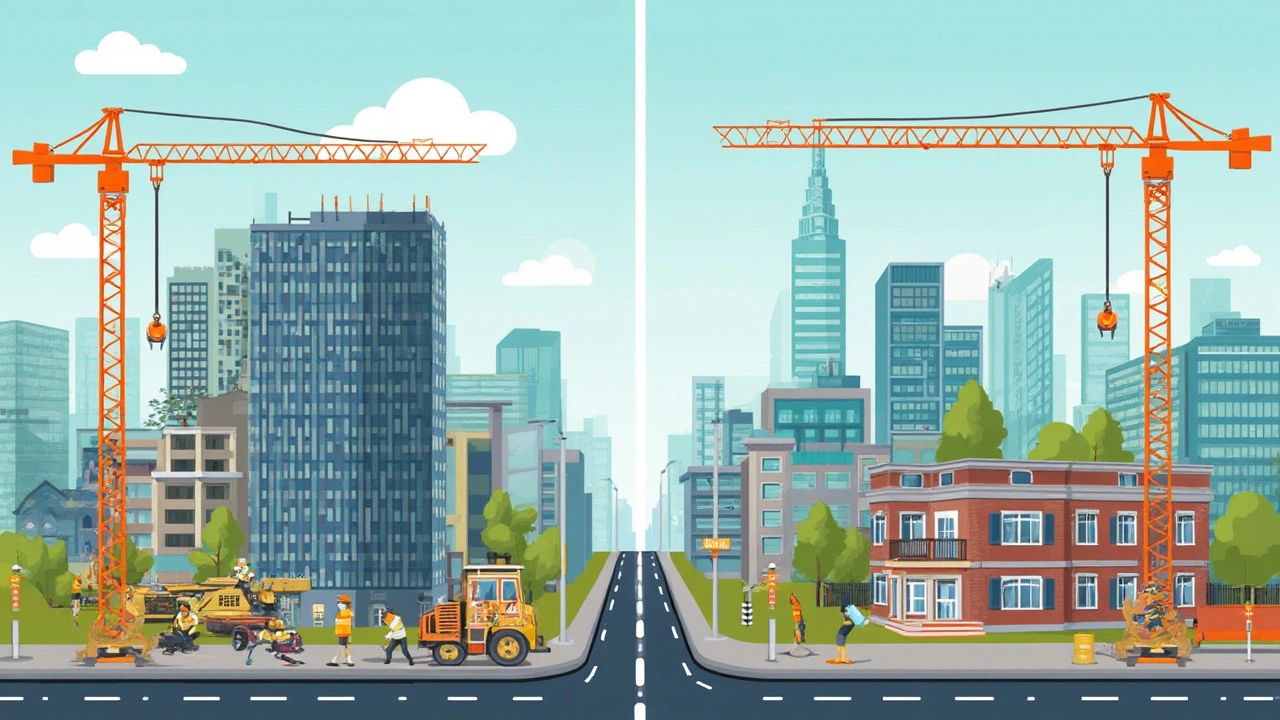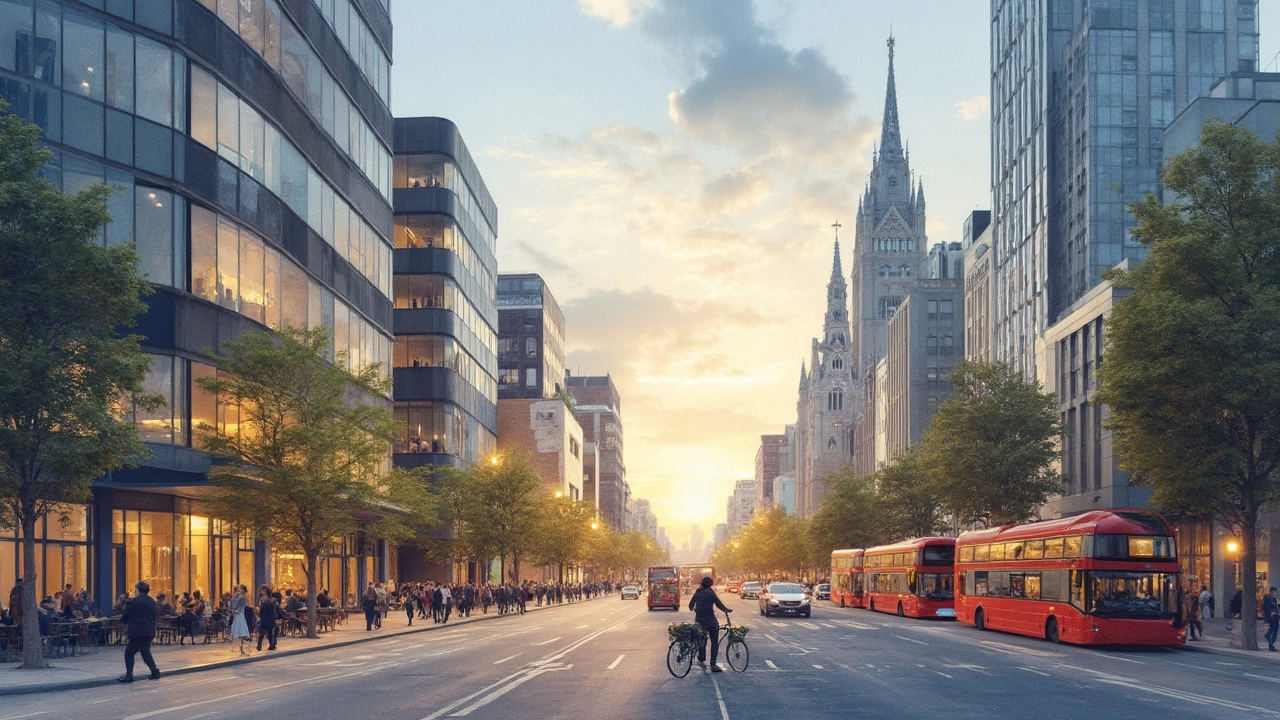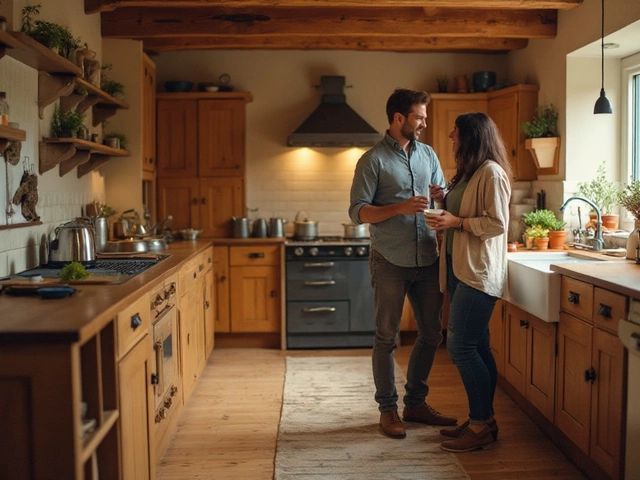Truth is, people mix up commercial and non-residential all the time. You might think they’re just two ways of saying the same thing, but that’s not really true in construction.
Here’s the trick: every commercial building is non-residential, but not all non-residential buildings are commercial. Sounds like a tongue twister, right? Basically, ‘non-residential’ covers anything that isn’t a home—so schools, hospitals, warehouses, even churches. ‘Commercial’ is a slice of that pie. It’s all about buildings where business happens—like stores, restaurants, banks, and offices.
When you’re planning a project or looking at properties, getting this difference straight actually saves you time, money, and a ton of headaches. Most city rules draw a clear line between these categories, and you want to be on the right side of that line. Trust me—mix ups mean delays and unexpected bills. And nobody wants that.
- Breaking Down the Terms
- What Belongs Where: Real-Life Examples
- Why Classification Matters
- Permits, Codes, and Zoning Issues
- Tips When Starting a Project
Breaking Down the Terms
Let’s clear up what these labels actually mean so you’re not left second-guessing during a big construction job. In the world of buildings, words matter—a lot.
Commercial buildings are where money changes hands, plain and simple. Think about offices, malls, restaurants, retail stores, and hotels. If the main goal is to run a business, offer services, or sell stuff, that’s commercial use. On the flip side, non-residential is this bigger category that means anything that’s not a house or apartment.
That includes all sorts of spaces:
- Commercial buildings (offices, restaurants, stores, shopping malls)
- Industrial buildings (factories, warehouses, plants)
- Institutional buildings (schools, hospitals, libraries)
- Government facilities (courthouses, fire stations)
- Recreational centers (gyms, stadiums)
- Religious facilities (churches, mosques, temples)
A quick stat: According to the U.S. Energy Information Administration’s 2018 report, there were over 5.9 million commercial buildings in the U.S., but when counting all non-residential buildings, that number jumps up thanks to the other categories mentioned above.
| Type | Main Purpose | Example |
|---|---|---|
| Commercial | Profit/Business | Grocery store, cinema, bank |
| Industrial | Production/Storage | Factory, warehouse |
| Institutional | Education/Health | Hospital, school |
| Recreational | Leisure/Sports | Stadium, gym |
| Religious | Worship/Community | Church, mosque |
If you’re talking with an architect or pulling permits, don’t just toss around “commercial” and “non-residential” as if they mean the same—local agencies expect you to use the right word; otherwise, paperwork gets messy fast. Every city has its own codebook dividing up these types, often tying each one to a different set of rules for things like fire safety or parking lots. Getting this nailed down upfront makes the rest of your project way smoother.
What Belongs Where: Real-Life Examples
Let’s get real. Tossing around terms is easy, but nothing beats clear examples. Here’s where the lines between commercial and non-residential buildings show up in everyday life.
Commercial buildings are what you hit up when you need something or want to spend money. Think of:
- Supermarkets like Walmart or Kroger — these pull in thousands of shoppers a day.
- Banks — every city’s sprinkled with them, and they’re designed for business, not for living or learning.
- Restaurants and fast food joints — whether it’s a Taco Bell or a fancy sit-down spot, the goal here is to sell food, and lots of rules apply.
- Office buildings — from sleek downtown towers to local dental practices, these are classic commercial properties.
But check out a hospital or a school nearby, and you’re in the land of non-residential—but not commercial—buildings. Nobody’s running a shop in an elementary school or making a profit off emergency rooms (not in the real estate sense, anyway). Here’s a closer look:
- Schools (elementary to university)
- Churches, mosques, or synagogues
- Hospitals and clinics
- City halls and libraries
- Warehouses and distribution centers
Sometimes, you get hybrids. For example, a hotel is commercial because it sells a service, but the line blurs when they add conference centers or wedding venues.
Want some perspective? Here’s how space gets used in the U.S. (based on recent stats):
| Type | Example | % of Non-Residential Floor Space |
|---|---|---|
| Office | Business towers, law firms | 17% |
| Retail / Commercial | Shopping centers, grocery stores | 15% |
| Education | Schools, colleges | 17% |
| Healthcare | Hospitals, clinics | 8% |
| Warehouse | Amazon fulfillment centers | 17% |
People often assume every big building is commercial, but as you can see, non-residential covers a bunch of uses that have nothing to do with business. Knowing these buckets helps a ton when you’re budgeting, seeking permits, or choosing the right team for a project.

Why Classification Matters
It might seem like splitting hairs, but figuring out whether a property is commercial or just “non-residential” changes everything when you’re actually building, buying, or investing. The rules aren’t just different in the law books—they hit your project right in the wallet and on your timeline.
Take building codes, for example. Fire safety, parking, accessibility—these all get stricter for a shopping center compared to a school or a warehouse. You can’t just start with one set of plans and hope they’ll pass if you switch up the building’s use halfway through.
Lenders and insurance companies also see a big gap between commercial and other non-residential buildings. Banks look at future business income potential, while insurance providers price out risk differently. Try getting a commercial loan for a property zoned as a church or a warehouse—it’s a different playbook.
Zoning rules are a whole different can of worms. If you want to build a strip mall on a plot that’s coded for community use, get ready to jump through applications, hearings, and maybe even public pushback. Here’s a quick look at how cities break it down:
| Building Type | Typical Zoning Code Example | Allowed Activities |
|---|---|---|
| Retail Store | Commercial (C-1, C-2) | Shops, restaurants, offices |
| School | Institutional (INST) | Education, community programs |
| Warehouse | Industrial (IND) | Storage, manufacturing |
| Hospital | Institutional (INST) | Medical services |
Miss the classification and you’ll run into issues right away. Common pain points include:
- Zoning violations and fines
- Long delays waiting for permits or variances
- Paying for costly redesigns or extra fees
- Trouble selling or refinancing the property later on
The bottom line? Don’t gloss over these categories—your budget and project speed depend on it.
Permits, Codes, and Zoning Issues
This is where confusion over commercial and non-residential really bites. You’ll hear stories about someone who thought their dog daycare (a commercial gig) followed the same rules as the community theater down the street (non-residential, but technically institutional). Guess what? The city had totally different requirements for each, and one project got put on hold for months.
Municipalities have strict processes for approving what gets built where. Permits are step one—if you try to skip them, inspectors can make you tear work out or even shut down your site. It’s not just red tape. Permits make sure your building follows safety codes and fits local zoning.
Building codes say what materials you can use, how fire exits are planned, the type and location of restrooms, and a ton of other nitty-gritty stuff. Commercial buildings, especially, are checked hard for things like accessibility, electric load, and sprinkler systems. For example, the Americans with Disabilities Act (ADA) ramps up rules in malls, shops, and offices more than most faith assembly buildings.
Zoning? This is the map that decides if your project can even happen in the first place. Cities break everything up—residential, commercial, industrial, and sometimes special categories like education or medical. If you want a restaurant in an industrial zone, good luck getting the green light without a special variance. And just because a property is non-residential doesn’t mean it’s ready for *commercial* use.
| Building Type | Typical Code Applied | Common Permit Cost Range (USD) |
|---|---|---|
| Commercial (Retail, Office) | IBC, ADA, Energy Code | $5,000 - $50,000+ |
| Institutional (Schools, Churches) | IBC, Local Fire & Safety | $3,000 - $25,000 |
| Industrial (Warehouses) | IBC, OSHA, Local Codes | $7,000 - $75,000 |
Here's a little tip: the word commercial on your permit application triggers a whole different review process. Expect closer fire inspections, stricter parking calculations, and sometimes environmental impact checks.
If you’re just starting out, talk to your city’s building office before you even get an architect. It’s way better to know the lay of the land than to discover, mid-project, that you got the category wrong and now owe thousands in redesign fees.

Tips When Starting a Project
Kicking off a building project isn’t just about picking a lot and throwing up walls. Getting the details right from day one keeps things smooth and legal. Here are some plain and honest tips you can actually use.
- Know your classification: First thing’s first—figure out if your place is classed as commercial or plain non-residential. You can’t build a retail store where the land is meant for schools or storage, no matter how sweet the spot looks. Local zoning offices or your city’s website list these breakdowns.
- Double-check zoning maps: Mistakes happen because people pull outdated maps or trust old info. Each year, cities update their zoning rules. Look up the latest. For reference, about 36% of zoning-related permit rejections in the U.S. are from using outdated info (source: American Planning Association, 2024).
- Permits take longer than you think: Commercial permits can take weeks or even months—way more complex than residential ones. Factor this into your timeline, or you’ll be scrambling. Some U.S. cities report average commercial permit processing times of 45–90 days.
- Set your budget with real numbers: Commercial building costs have shot up, with 2025 averages around $300 per square foot for basic office spaces, and higher for retail or specialty builds. Plan for extra, just in case.
- Work with pros who know the game: Architects and project managers with experience in your building type will save you money and stop rookie mistakes. Ask to see their track record before you sign anything.
Want some quick-reference numbers? Here’s what you should double-check when launching your project:
| Step | Average Time | Typical Cost (USD) |
|---|---|---|
| Zoning Verification | 1–2 weeks | $500–$2,000 (consultant fees) |
| Permit Approval (Commercial) | 45–90 days | $2,000–$30,000 |
| Architect/Design Fees | 4–8 weeks | 5–10% of total build cost |
| Construction | 3–12 months | $300+ per sq ft |
Never guess on any of these steps. Doing the homework early means fewer surprises—and your money will go where it should.





